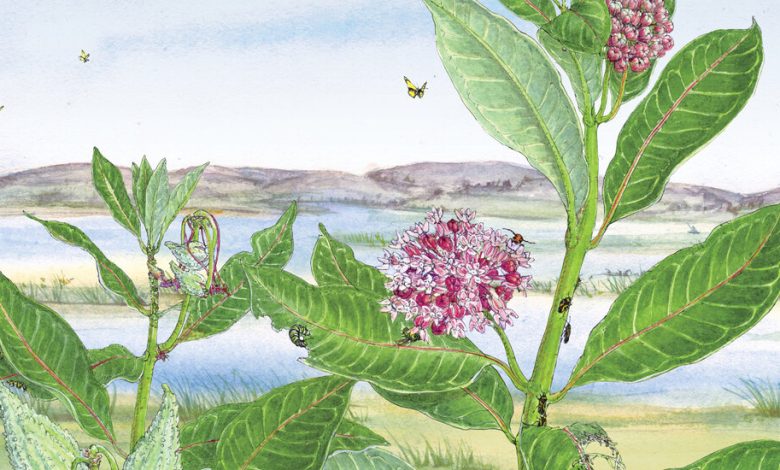If You Plant Milkweed, They Will Come. (And Not Just the Butterflies.)

To see a field of common milkweed in midsummer — a sea of a thousand nodding pink flower heads — you would not imagine that anything could ever stand in the way of the genus Asclepias.
Yes, common milkweed (Asclepias syriaca), the most widespread milkweed east of the Rocky Mountains, can colonize disturbed sites and form impressive stands. But it is an exception among the more than 90 recognized North American species of milkweed, many of which often find it not so easy to continue making themselves at home.
“The milkweed is a displaced citizen in its own land,” writes Eric Lee-Mäder in the opening of his new book, “The Milkweed Lands: An Epic Story of One Plant, Its Nature and Ecology.” “Where once it owned the continent, it’s now a kind of vagrant, occupying the botanical equivalent of homeless encampments.”
As one example, he cites 2012 research, by John M. Pleasants of Iowa State University and Karen S. Oberhauser of the University of Minnesota, that estimates a nearly 60 percent decrease in the milkweed populations of the Midwest since 1999.
“Milkweeds, at least the North American ones, are like so many other meadow and grassland species,” Mr. Lee-Mäder said in a recent conversation. “They’re both dependent upon us and also subject to the various indignities of coexisting with us.”
The beginnings of our agrarian legacy set much of their displacement in motion, when vast tracts of original prairie sod were plowed up to create croplands. Since the 1990s, the use of increasingly sophisticated chemical herbicides that kill everything but the crops genetically engineered to resist them has essentially “targeted milkweeds for elimination,” he said.
Once, milkweed “would get shredded and pulverized by cultivation equipment, but it would spring back from the live rhizomes underground,” he continued. Now, “the milkweed within those systems just dies.”
We have relegated milkweed to ditches and abandoned lots, said Mr. Lee-Mäder, an ecologist at the invertebrate-focused Xerces Society, where he is the co-director of pollinator and agricultural biodiversity. He directs the nonprofit’s private-sector initiatives, supporting pollinator-conservation work across thousands of acres with companies like General Mills, Nestlé and Danone, undertaking habitat restoration on farms that supply them with ingredients like almonds and blueberries.
Mr. Lee-Mäder and his wife, Mari Lee-Mäder, also operate Northwest Meadowscapes, in Port Townsend, Wash., a supplier of regional native seeds that also provides consultation services for meadow makers.
They know something that anyone who gives milkweed refuge will soon learn: If you welcome this plant, a diverse, living fan base will follow close behind — and not only monarch butterflies.
If you plant it, they will come. Sometimes as if out of thin air.
A Two-Way Chemistry Equation
If someone says “milkweed,” maybe you also hear “monarch butterfly” in your head. It’s almost as if the two are inextricably linked.
Mention of this plant probably also brings to mind stories of its distinctive chemistry. Many plants defend themselves against herbivory by producing unpalatable or toxic chemicals, but “milkweeds take this strategy especially seriously,” Mr. Lee-Mäder writes.
Asclepias produce potent steroids called cardenolides “that can disrupt the life functions of vertebrate animals unlucky enough to feed on them,” he adds. (A bonus: These chemicals may also discourage deer.)
But while milkweeds have evolved their chemical defenses to protect themselves, they may also “be gifting these chemical defenses to some of the animals that live in association with them,” Mr. Lee-Mäder said, “as much as using these to check and control the amount of herbivory that they have to sustain.”
One notable example: monarchs, which have famously evolved to ingest milkweeds without harm. Their larvae rely on Asclepias as an obligate host plant, or a food required for at least one stage of development. Eating it fosters an anti-predation chemical defense of their own.
So critical is this relationship that female monarchs lay their eggs on milkweed leaves, ensuring that the needed sustenance is at hand when offspring emerge.
“They use their olfactory sense to identify the locations of milkweeds on wind currents,” Mr. Lee-Mäder said, “tracking those down like bloodhounds on a trail, to be able to lay their eggs on those plants.”
The monarch-milkweed connection is often spoken of as “chemical warfare,” but Mr. Lee-Mäder prefers to think of it as a “two-way relationship” or “a partnership.”
The monarchs’ part: Although the adult butterflies are not great pollinators, they do visit milkweed flowers for nectar, potentially moving some pollinia (milkweeds’ pollen-bearing structures) long distances during their migrations.
“That gene flow that monarchs may facilitate is probably unmatched by other flower visitors to milkweeds,” Mr. Lee-Mäder said.
Not Just Monarchs
As intimate and celebrated as the plants’ relationship with monarchs is, the community surrounding milkweeds is far more diverse.
“The hungry throng” that Mr. Lee-Mäder enumerates includes at least 40 insect species that “feed often or exclusively on North American milkweeds in the summer,” he writes. They include butterflies, moths, beetles and aphids.
In a milkweed seed-farm field in the Midwest, he recalls witnessing a cloud of aphids descend on the breeze, as if tuned in by GPS to the emerging crops’ location. “It’s like seeing nature sort of manifest itself out of thin air around this plant,” he said.
Before you say, “No, not aphids; not in my garden,” think about their role in the big picture, Mr. Lee-Mäder said — as food for beneficial insects like lady beetles and lacewing insects, for instance, which are, in turn, food for birds. And one of the most abundant milkweed-visiting aphids, the nonnative oleander aphid, is host-specific, meaning it doesn’t eat other plants.
Other invertebrates, including slugs, snails and spider mites, may feast on milkweeds, too, as do some larger animals, like rabbits and ground squirrels, which are apparently resistant to poisoning.
Beyond so many opportunities for herbivory, Asclepias flowers provide nectar to adult butterflies and moths, along with an astonishing lineup of bee species and wasps.
And just look at them: Milkweeds are “among the most elaborate in the plant kingdom,” he writes, with “a complexity comparable to that of rare orchids.”
Which Ones to Grow?
It’s easy to take delight in a stand of common milkweed or its Western counterpart, showy milkweed (A. speciosa) — whether in bloom or later, holding their substantial seed-filled pods, or follicles. Lanky as these three- or four-footers may be, they put you “face to face with the wildness of what this genus can represent,” Mr. Lee-Mäder said.
He expresses awe for rush milkweed (A. subulata), a three- to five-foot plant with whitish-green blooms that grows alongside the Joshua tree (Yucca brevifolia) in nearly rainless parts of the desert Southwest. “It’s a plant made up of stems — it produces almost no leaves,” he said, explaining its adaptation for survival.
There are other choices for gardens without a meadow-size space to offer, though, or those that aren’t in the most arid places.
It’s no surprise that butterfly weed (A. tuberosa), with its vivid orange flowers, has received the most horticultural attention.
“It’s beautiful, it’s compact, it’s charismatic,” Mr. Lee-Mäder said, noting also that orange is fairly uncommon among prairie and meadow flowers. Although the palette of Asclepias is generally quite different from East to West, “tuberosa is one that crosses the Continental Divide,” he said, residing even in parts of the desert Southwest.
At just about two and a half feet high, a mature plant can produce “strikingly abundant blooms for the space that it takes up, and attract a really remarkable spectrum of flower visitors,” he added. It is also pretty well adapted to the often highly altered soils of our human landscapes.
As its common name implies, swamp milkweed (A. incarnata), with its distinctive magenta flowers on stems of up to about four feet, can handle it wet. With rain gardens and bioswales increasingly being planted to manage more insistent runoff in a changing climate, this widespread species should get more play. Do you have a spot for it just beneath a downspout, or maybe at a pond’s edge?
Another important but underappreciated species that Mr. Lee-Mäder wants to put in a word for, especially with Western gardeners, is the lavender-and-white-flowered narrowleaf milkweed (A. fascicularis), “one of the most widespread breeding plants for Western monarchs,” he said.
Unlike Eastern butterfly populations, which overwinter in Mexico, Western monarchs spend the winter in coastal California and then move inland around March for breeding season. Their clusters break up and typically move straight westward, into the Central Valley or Sierra Nevada foothills, fanning out from there.
“A monarch that wintered in Monterey might end up in Las Vegas or Boise or Spokane that next spring and summer,” he said. They need more narrowleaf milkweed along their routes.
Like so many native plants, milkweeds may have persisted only on the fringes in nature, but gardeners can offer them prominent spots. A good place to begin researching which ones to choose is the Xerces Society’s Project Milkweed and its region-specific plant lists.
“Planting milkweeds in a garden may be a small dent — but it’s a dent,” Mr. Lee-Mäder said. “If everybody does it, it will add a different kind of richness to our landscapes.”
Margaret Roach is the creator of the website and podcast A Way to Garden, and a book of the same name.
For weekly email updates on residential real estate news, sign up here.




